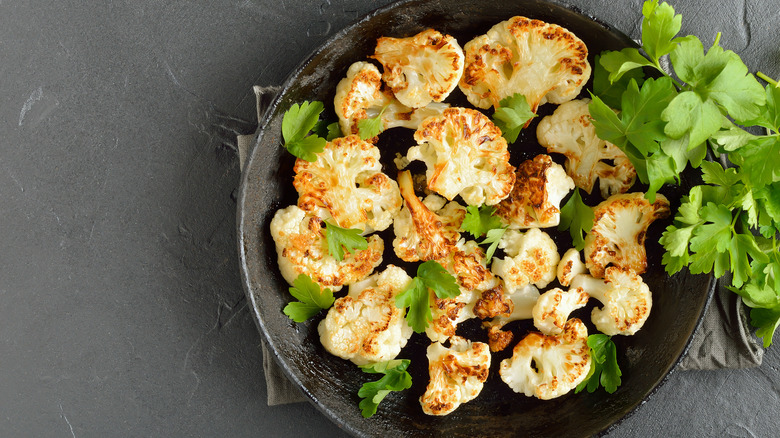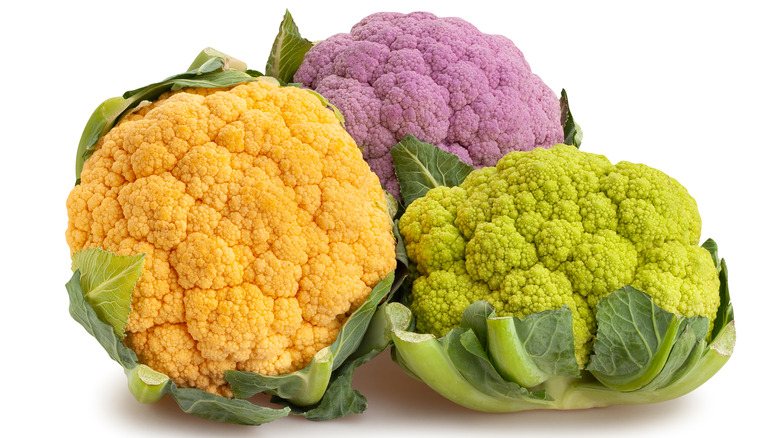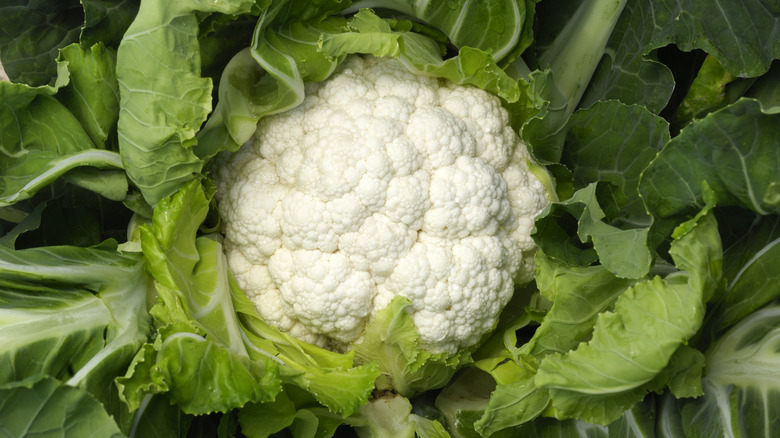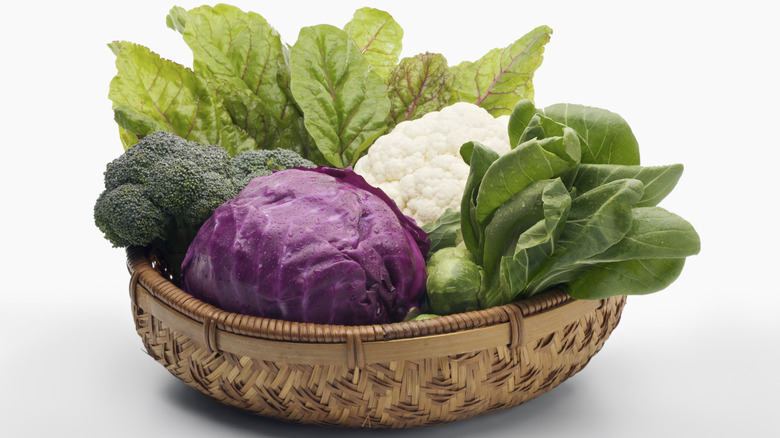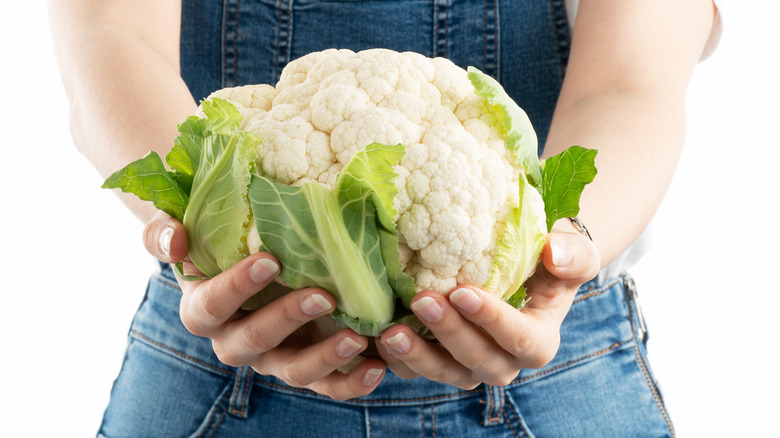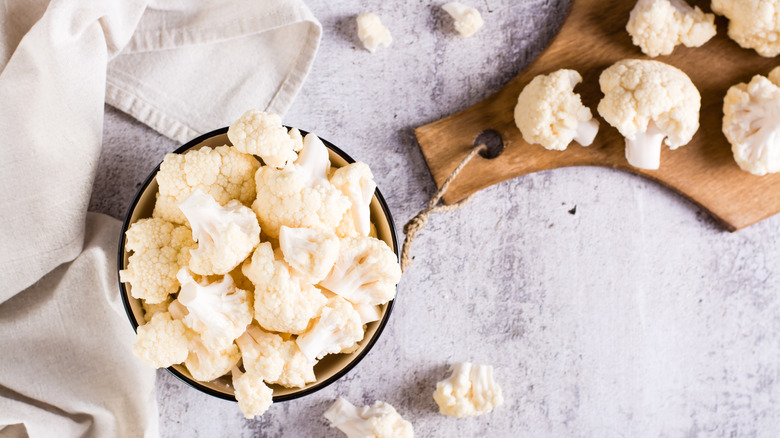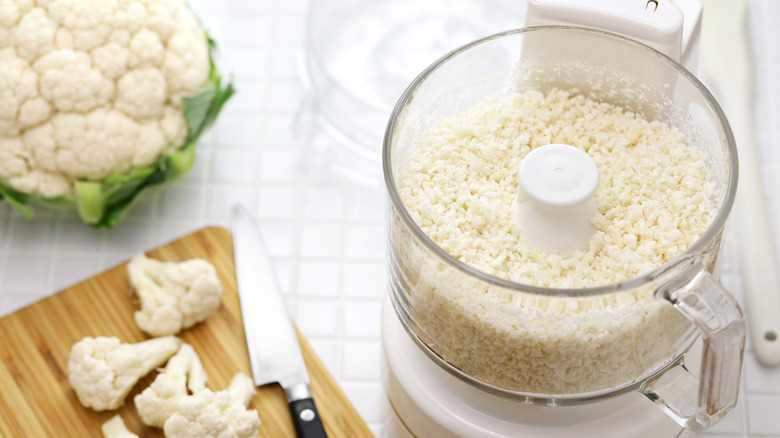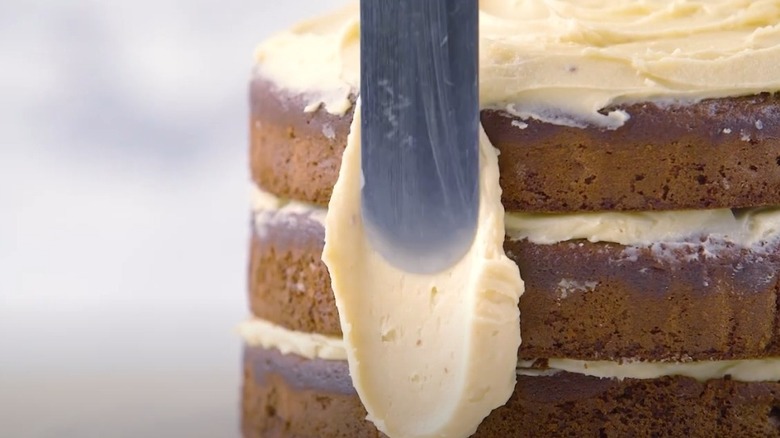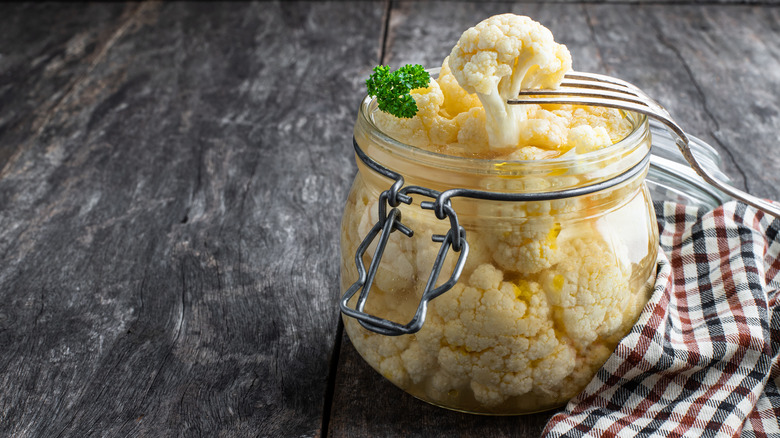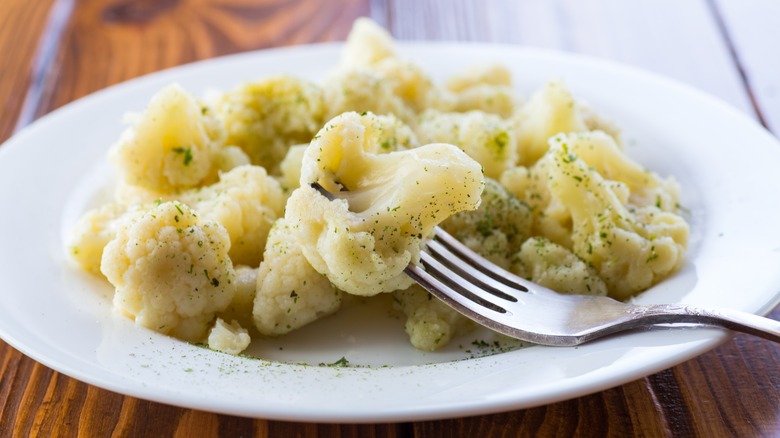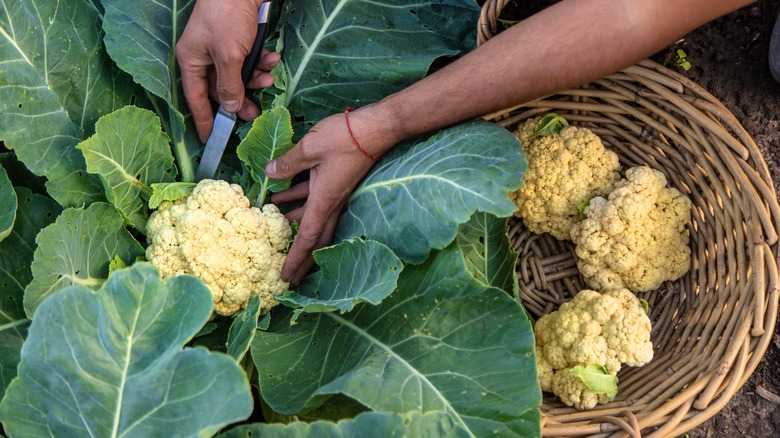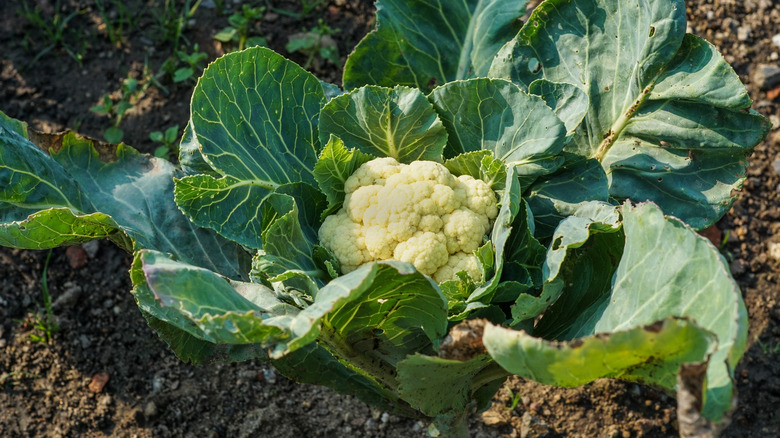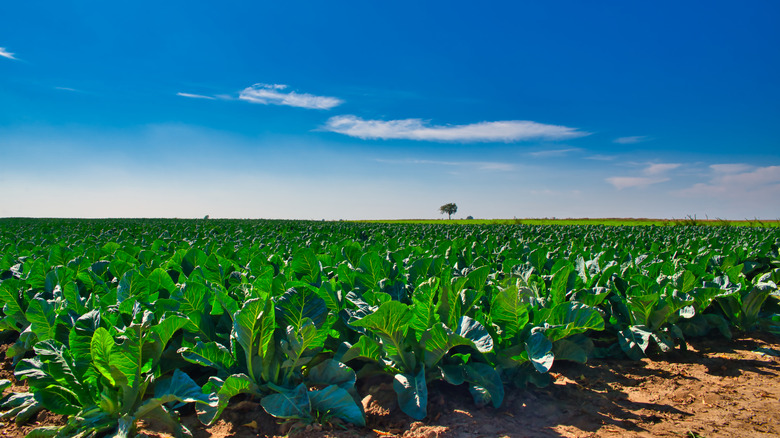Everything You Need To Know About Cauliflower
Few foods stand as versatile and nutritionally dense as the humble cauliflower. This tasty cruciferous vegetable is an unassuming food, sometimes overshadowed by other, more vibrant veggies, but cauliflower possesses an array of surprising characteristics. From its wide uses in the kitchen to the way it grows, there's so much to learn about this wholesome fridge staple.
For example, did you know that cauliflower comes in a kaleidoscope of different colors? And have you ever tried eating those leafy greens surrounding its crown? There's certainly more to this vegetable than meets the eye, and there's huge scope for creativity when it comes to cooking, and even baking sweet treats, with cauliflower. Whether enjoyed raw as a crunchy snack or transformed into a low-carb rice substitute, cauliflower is well-loved among health-conscious foodies.
What truly sets cauliflower apart, however, is its nutritional value. It's bursting with essential vitamins, minerals, and antioxidants, and we'll delve into the unique health benefits it can bring to your table. There's something for everyone when it comes to this versatile veggie, so join us on a journey through the marvels of cauliflower and learn how you can fully harness its culinary potential.
It comes in different colors
The classic white variety is the one most commonly found in grocery stores, but cauliflower has a range of vibrant counterparts. This veggie also comes in purple, orange, and green varieties, with each offering a distinct flavor and range of nutritional benefits.
The creamy-white and most recognizable form of cauliflower possesses a mild, slightly sweet flavor. It serves as a wonderful canvas in a range of recipes, since it effortlessly absorbs the flavors of accompanying ingredients.
In contrast, the striking purple cauliflower, with its rich violet hue, can add a pop of color to any dish. This vibrant variant gets its color from the presence of anthocyanins, potent antioxidants known for their anti-inflammatory properties. As well as its visual appeal, purple cauliflower also offers a unique, slightly nutty taste, and takes a little less time to cook than white cauliflower.
Orange cauliflower is another colorful twist on the traditional variety. Its cheerful florets get their distinctive coloring due to their high beta-carotene content, a precursor to vitamin A which is essential for eye health. Orange cauliflower tends to taste slightly sweeter and creamier than white cauliflower.
Finally, the green cauliflower, also known as broccoflower or Romanesco, features an intricate pointy floret structure — somewhat resembling a miniature forest. This variety has a more delicate flavor, with notes similar to both cauliflower and broccoli.
You can eat the leaves
Often tossed away unused, the leaves of cauliflower can in fact be a tasty addition to your dinner. Adding texture, flavor, and nutrition to dishes, they definitely deserve a place on the plate.
Rich in vitamins, minerals, and fiber, cauliflower leaves boast a nutritional profile comparable to other leafy greens like kale, spinach, and cabbage. Packed with vitamin C, vitamin A, and folate, they can bring plenty of goodness to any meal. Cauliflower leaves have a subtle, earthy flavor with a hint of nuttiness, so they're super versatile too. Try sautéing them with garlic and olive oil for a simple side dish, tossing them into a soup or stew for added flavor, or incorporating them into stir-fries and salads for a nutritious boost.
As well as the leaves, the cauliflower core is also entirely edible. Try eating it raw by slicing it into sticks for dipping, blitzing it into cauliflower rice, or simply roasting it with a little olive oil and your favorite seasonings. An added benefit that also comes with eating every part of your cauliflower is that it helps to reduce food waste — an increasingly pressing concern in today's world.
It's actually a form of cabbage
Despite its distinctive appearance and flavor, cauliflower actually comes under the same species as cabbage, Brassica oleracea. This also includes familiar veggies like broccoli, kale, and Brussels sprouts. Each variant within the species has been selectively bred over centuries to develop unique attributes, resulting in the diverse array of vegetables we enjoy today.
The cauliflower we know and love is distinguished by its compact head. Unlike its cabbage cousins, cauliflower lacks a dense, leafy structure, featuring florets instead. These florets are in fact immature flower buds that have become tightly packed together. According to Plants and Pipettes, cauliflower is "a cabbage plant that grows to maturity, starts to make a flower and then just ... fails. Instead, the poor plant gets stuck in a loop of making more and more inflorescences (flower clusters), which also don't make it."
Thankfully, this "mutant cabbage" is rather delicious, with those compact florets offering their own unique flavor and texture profile. Despite this, cauliflower does share many nutritional similarities with cabbage and other leafy greens.
It's packed with nutrients
This humble veggie also packs a punch in the nutrition department. Cauliflower is of course wonderfully versatile and delicious, but it also contains a wealth of vitamins, minerals, and antioxidants.
One of cauliflower's standout nutritional features is its impressive vitamin C content. Just one cup of raw cauliflower provides over half of the recommended daily intake of this vital nutrient, supporting immune function and skin health. Additionally, cauliflower serves as an excellent source of vitamin K, crucial for blood and bone health, as well as folate, which is essential for cell division and the formation of DNA.
Cauliflower's array of minerals, including potassium and magnesium, also play keys roles in maintaining nerve and muscle function in the body. Furthermore, its rich antioxidant content, including compounds like glucosinolates and carotenoids, enhances its nutritional profile even more, helping to protect our cells from oxidative stress and reducing the risk of developing a range of chronic diseases. As it's high in fiber, eating cauliflower also aids digestion and helps to keep you feeling full for longer, while its low glycemic index means it wont cause any dramatic spikes in your blood sugar levels.
You can eat it raw
If you thought cauliflower had to be cooked before enjoying, you're about to have your mind blown. Raw cauliflower is delicious, nutritious, and can absolutely be eaten as is. It has a mild, slightly sweet flavor that pairs well with a variety of other ingredients.
One of the most appealing aspects of raw cauliflower is its crisp, crunchy texture, which is similar to other raw veggies like carrots and bell peppers. Its satisfying crunch makes raw cauliflower a wonderful addition to crudité platters and salads. Try chopping florets up into bite-sized pieces and dipping them into lemon hummus or garlic aioli, or slicing the cauliflower thinly before adding it to a vibrant salad with other vegetables, herbs, and a tangy dressing.
Furthermore, when we cook cauliflower (especially if opting for the boiling technique) some of its nutrients are lost. So, when we enjoy it in its raw form, all of those amazing vitamins, minerals, and antioxidants that cauliflower contains will be completely preserved.
You can make a rice replacement with it
Cauliflower isn't just reserved for steaming, boiling, and roasting. Why not try using it to create a healthy and low-carb alternative to rice?
To make cauliflower rice, you'll first need to break the raw cauliflower down into very small pieces. You can either do this by pulsing it in a food processor, or using a box grater. Next, you'll want to squeeze the blitzed or grated cauliflower in some kitchen towels to get rid of any excess moisture ... no one wants soggy rice after all. Then, your cauliflower rice is ready to use in your recipes. A great way to cook it is sautéing it in a frying pan with a little oil. Place a lid on top to help it steam and gently cook through.
Cauliflower rice offers a lighter, more nutrient-dense option compared to traditional rice. It can serve as a great addition to a stir-fry, a side with curry or chili, an element of a hearty grain bowl, or as the primary component of a cauliflower fried rice dish that incorporates other veggies and seasonings. Since is readily absorbs the flavors of other ingredients, cauliflower rice makes the perfect base for a wide range of dishes.
It's incredibly versatile
When it comes to versatility, cauliflower ranks highly, with this tasty vegetable having earnt a reputation as a bit of a culinary chameleon. Cauliflower has the ability to adapt seamlessly to a range of cooking techniques and flavor profiles, so it's an amazing staple to have on hand.
Cauliflower can be riced, mashed, steamed, boiled, or roasted, among other prep methods. It lends itself to a wide range of cuisines, from comforting curries and hearty stews to a spicy stir-fry. Its neutral flavor profile and robust texture make it an incredibly versatile addition to a variety of dishes.
One of our favorite ways to use cauliflower is BBQ cauliflower wings, which are coated in a spicy batter, tossed in panko breadcrumbs, and popped in the air fryer until golden brown. Or, if you're after something warming and satisfying, try this easy, garlicky cauliflower soup. Cauliflower cheese is of course also a much-loved veggie side dish, where gooey, melty cheddar serves as the perfect pairing for the mild sweetness of the cauliflower.
You can make cakes with it
Believe it or not, cauliflower isn't just reserved for savory dishes — it can also serve as a useful ingredient in homemade cakes. Cauliflower has a mild flavor and moist texture, making it an ideal way to add nutrition and moisture to cakes without affecting the taste.
When incorporated into cake recipes, cauliflower adds moisture and tenderness, and you won't even know it's in there! Whether you're whipping up a chocolate, vanilla, or lemon cake, the subtle flavor of the cauliflower allows the other ingredients in the cake to shine.
There are many ways to incorporate cauliflower into cake recipes. The method of choice is often blending it up into a smooth purée, so there won't be any chunks of cauliflower in sight. However, adding grated cauliflower to the batter can be a great way to add texture too. Some recipes combine cauliflower with alternative flours such as almond and flaxseed flours, with the result being a moist and flavorful low-carb dessert. Plus, baking with cauliflower provides a creative way to sneak extra vegetables into your diet, so it's a great way to boost a picky eater's veggie intake.
You can pickle it
Enthusiasts will be pleased to know that cauliflower is a vegetable that lends itself beautifully to the art of pickling. With the option to personalize the pickling liquid with different spices, pickled cauliflower is delightfully tangy, crunchy, and full of flavor.
When pickling cauliflower, there's no need to cook it first. Simply break it up into florets when raw and pop it into a large jar along with any other ingredients. Coriander seeds and mustard seeds, as well as chili flakes, are popular additions. You could even add some other sliced veggies like red onion, carrots, or green beans. Then, gently heat a mixture of vinegar, water, salt and sugar in a saucepan, and pour it over the cauliflower to fill the jar. Pop the lid on and let it cool before transferring to the fridge to chill and let all those flavors mingle. You'll want to wait at least a week before using it.
Pickled cauliflower is great for adding a refreshing zing to salads, sandwiches, charcuterie boards, and more. It's a versatile condiment that you'll find beautifully complements a wide range of dishes.
Steaming cauliflower preserves more nutrients than boiling it
When preparing your cauliflower, the cooking method you choose doesn't only impact taste and texture; it can also significantly impact its nutritional content. Boiling and steaming are common cauliflower cooking techniques, and steaming comes out on top as the superior method for preserving the vegetable's nutrients.
Steaming cauliflower exposes it to gentle heat and moisture, which means it cooks evenly while retaining texture and nutrients. When steaming, you can preserve cauliflower's water-soluble vitamins, such as vitamin C and B vitamins, some of which would have leached into the cooking water and been lost if boiling. The high temperatures and longer cooking times associated with roasting or grilling cauliflower also cause more degradation of these nutrients than steaming.
Plus, steaming cauliflower helps to maintain its crisp texture, as well as preserving the vibrant coloring of purple or orange cauliflower. Boiled cauliflower, especially if cooked for too long, can become dull, waterlogged and mushy.
To steam cauliflower, place a steamer basket into a saucepan and toss in the florets. You'll need to add just enough water to cover the bottom of the pan, not fully submerge the cauliflower. Once the water is boiling, pop a lid on to trap in the steam, reduce to a simmer and leave to cook for about six minutes. It's a quick and simple method that will ensure every bite is crisp and packed with goodness.
A whole cauliflower contains fewer calories than a muffin
Despite its satisfying taste and versatility, cauliflower has a relatively low calorie count. Amazingly, you could eat an entire head of cauliflower and you'd still be consuming fewer calories than a standard muffin!
According to the USDA, a large head of cauliflower, typically weighing around 30 ounces, contains approximately 190 calories. In contrast, a medium-sized blueberry muffin packs approximately 420 calories, with some larger varieties containing over 600. Since cauliflower is often used as a replacement for other carbs like rice and potatoes, it's surprising that this veggie isn't more calorific. Instead, it offers a nutrient dense, satisfying eating experience without the excess calories.
Sweet treats can absolutely be enjoyed as part of a healthy diet and lifestyle, but in essence, it's all about balance, and cauliflower is certainly a great food to incorporate into your diet.
It grows in relatively cool temperatures
Unlike some other crops that require warmer temperatures to flourish, cauliflower actually thrives in cooler climates. Their resilient nature means they can be grown year-round in parts of the world with temperate climates.
Cauliflower crops will do best in temperatures between 54 to 72 degrees Fahrenheit. In cooler weather, frost can be an issue, which can lead to stunted growth and discoloration. Hotter temperatures can also have the same effect. Therefore, in most parts of the U.S., cauliflower is best planted in either spring or fall, to avoid the hottest part of the summer.
The seedlings are typically sown in the soil about 20 inches apart, in a row formation. With plenty of water, sun exposure, and well-draining soil, they should be ready to harvest within two to three months. At its prime, a cauliflower should have a large, full head and compact florets that are free of blemishes.
You can even grow cauliflowers in your own back yard. You'll need to germinate the seedlings indoors first, before transferring them to the soil or a large pot outside. As long as the container has a depth and width of 12 inches or more and good drainage holes, you're good to go. Plant the seedlings in some potting mix, water and fertilize frequently, and you'll soon be enjoying home-grown cauliflower for dinner.
You can hear them growing
Yes, you read that right. The "cauliflower creaks" is a real phenomenon, where peculiar squeaking noises can be heard emanating from cauliflower fields.
These strange noises emitted by the cauliflowers are actually triggered by the rapid growth of the vegetable's florets as they exert pressure against each other. The creaks are most noticeable during a spell of particularly favorable growing conditions, when cauliflowers will often have a speedy growth spurt. Amazingly, they can grow up to three centimeters in one day!
In an interview with Vice, British farmer David Simmons described this distinctive sound. "It's a bit like Rice Krispies [cereal] in a bowl. You pour milk in, hear it popping. It's that sort of noise, when it's very still in the morning." So, it seems that birdsong isn't the only noise you can expect to encounter in the tranquil countryside.
Cauliflowers aren't alone in their ability to vocalize their growth either. "Forced" rhubarb, which is grown in the dark to promote rapid growth, results in a similar chorus of sounds as the plants stretch and strain towards maturity.
California is the biggest producer of cauliflower in the US
The state that holds the prestigious title of being America's largest producer of cauliflower is California. With its fertile soil, favorable climate, and ample farmland, California is home to an impressive cauliflower industry that supplies fresh, high-quality produce to dinner tables across the country.
In 2023, California produced a staggering 400,000 tons of cauliflower. And it isn't just the domestic market that this state covers. As well as producing about 90 perfect of the cauliflower supply in the US, California's cauliflower industry plays a significant role in international trade, exporting a substantial portion of its harvest to countries around the globe.
With cauliflower consumption rising in popularity, demand for this crop has significantly increased in recent years. In fact, in Santa Barbara, cauliflower is now the second most prevalent crop, with strawberries taking the top spot. The boom of cauliflower rice is thought to be one of the reasons why production of this veggie has sky-rocketed.
